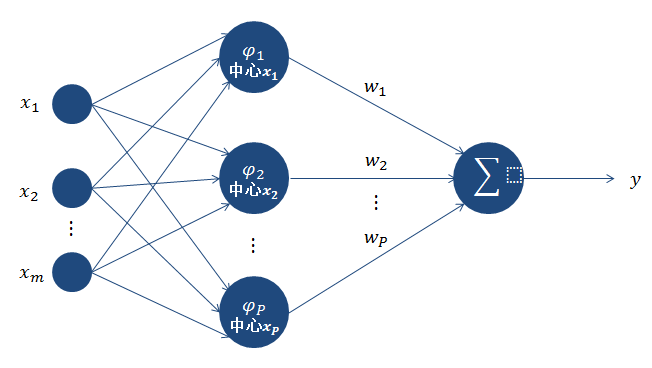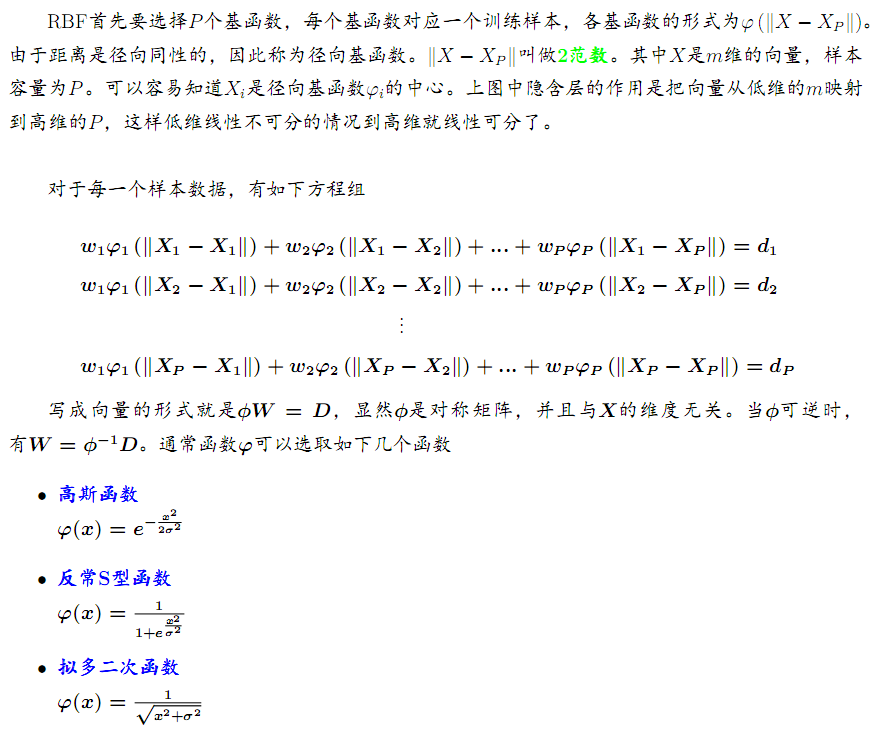RBF网络能够逼近任意非线性的函数。可以处理系统内难以解析的规律性,具有很好的泛化能力,并且具有较快的学
习速度。当网络的一个或多个可调参数(权值或阈值)对任何一个输出都有影响时,这样的网络称为全局逼近网络。
由于对于每次输入,网络上的每一个权值都要调整,从而导致全局逼近网络的学习速度很慢,比如BP网络。如果对于
输入空间的某个局部区域只有少数几个连接权值影响输出,则该网络称为局部逼近网络,比如RBF网络。接下来重点
先介绍RBF网络的原理,然后给出其实现。先看如下图
正则化的RBF网络参考这里。下面是网上找的一个比较好的Python的RBF网络实现。
代码:
from scipy import *
from scipy.linalg import norm, pinv
from matplotlib import pyplot as plt
class RBF:
def __init__(self, indim, numCenters, outdim):
self.indim = indim
self.outdim = outdim
self.numCenters = numCenters
self.centers = [random.uniform(-1, 1, indim) for i in xrange(numCenters)]
self.beta = 8
self.W = random.random((self.numCenters, self.outdim))
def _basisfunc(self, c, d):
assert len(d) == self.indim
return exp(-self.beta * norm(c-d)**2)
def _calcAct(self, X):
# calculate activations of RBFs
G = zeros((X.shape[0], self.numCenters), float)
for ci, c in enumerate(self.centers):
for xi, x in enumerate(X):
G[xi,ci] = self._basisfunc(c, x)
return G
def train(self, X, Y):
""" X: matrix of dimensions n x indim
y: column vector of dimension n x 1 """
# choose random center vectors from training set
rnd_idx = random.permutation(X.shape[0])[:self.numCenters]
self.centers = [X[i,:] for i in rnd_idx]
print "center", self.centers
# calculate activations of RBFs
G = self._calcAct(X)
print G
# calculate output weights (pseudoinverse)
self.W = dot(pinv(G), Y)
def test(self, X):
""" X: matrix of dimensions n x indim """
G = self._calcAct(X)
Y = dot(G, self.W)
return Y
if __name__ == '__main__':
n = 100
x = mgrid[-1:1:complex(0,n)].reshape(n, 1)
# set y and add random noise
y = sin(3*(x+0.5)**3 - 1)
# y += random.normal(0, 0.1, y.shape)
# rbf regression
rbf = RBF(1, 10, 1)
rbf.train(x, y)
z = rbf.test(x)
# plot original data
plt.figure(figsize=(12, 8))
plt.plot(x, y, 'k-')
# plot learned model
plt.plot(x, z, 'r-', linewidth=2)
# plot rbfs
plt.plot(rbf.centers, zeros(rbf.numCenters), 'gs')
for c in rbf.centers:
# RF prediction lines
cx = arange(c-0.7, c+0.7, 0.01)
cy = [rbf._basisfunc(array([cx_]), array([c])) for cx_ in cx]
plt.plot(cx, cy, '-', color='gray', linewidth=0.2)
plt.xlim(-1.2, 1.2)
plt.show()
最后提供Github上的一个C++实现的RBF,供日后参考。
























 1397
1397











 被折叠的 条评论
为什么被折叠?
被折叠的 条评论
为什么被折叠?








